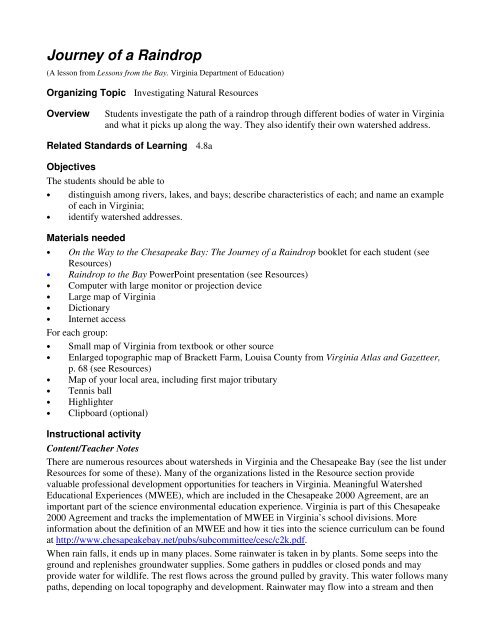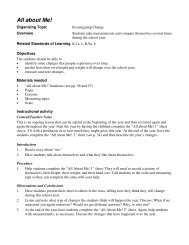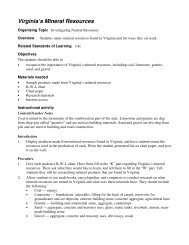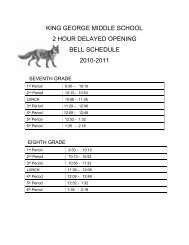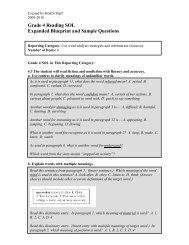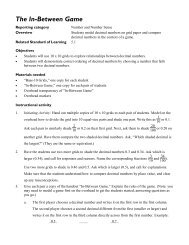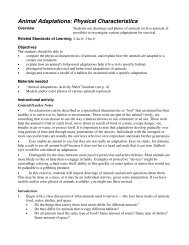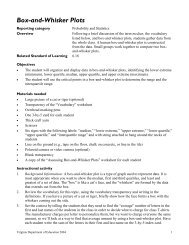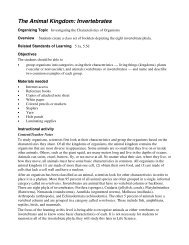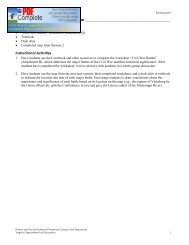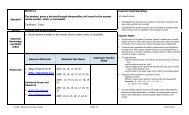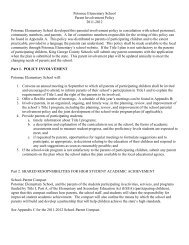Journey of a Raindrop
Journey of a Raindrop
Journey of a Raindrop
You also want an ePaper? Increase the reach of your titles
YUMPU automatically turns print PDFs into web optimized ePapers that Google loves.
<strong>Journey</strong> <strong>of</strong> a <strong>Raindrop</strong><br />
(A lesson from Lessons from the Bay. Virginia Department <strong>of</strong> Education)<br />
Organizing Topic Investigating Natural Resources<br />
Overview<br />
Students investigate the path <strong>of</strong> a raindrop through different bodies <strong>of</strong> water in Virginia<br />
and what it picks up along the way. They also identify their own watershed address.<br />
Related Standards <strong>of</strong> Learning 4.8a<br />
Objectives<br />
The students should be able to<br />
• distinguish among rivers, lakes, and bays; describe characteristics <strong>of</strong> each; and name an example<br />
<strong>of</strong> each in Virginia;<br />
• identify watershed addresses.<br />
Materials needed<br />
• On the Way to the Chesapeake Bay: The <strong>Journey</strong> <strong>of</strong> a <strong>Raindrop</strong> booklet for each student (see<br />
Resources)<br />
• <strong>Raindrop</strong> to the Bay PowerPoint presentation (see Resources)<br />
• Computer with large monitor or projection device<br />
• Large map <strong>of</strong> Virginia<br />
• Dictionary<br />
• Internet access<br />
For each group:<br />
• Small map <strong>of</strong> Virginia from textbook or other source<br />
• Enlarged topographic map <strong>of</strong> Brackett Farm, Louisa County from Virginia Atlas and Gazetteer,<br />
p. 68 (see Resources)<br />
• Map <strong>of</strong> your local area, including first major tributary<br />
• Tennis ball<br />
• Highlighter<br />
• Clipboard (optional)<br />
Instructional activity<br />
Content/Teacher Notes<br />
There are numerous resources about watersheds in Virginia and the Chesapeake Bay (see the list under<br />
Resources for some <strong>of</strong> these). Many <strong>of</strong> the organizations listed in the Resource section provide<br />
valuable pr<strong>of</strong>essional development opportunities for teachers in Virginia. Meaningful Watershed<br />
Educational Experiences (MWEE), which are included in the Chesapeake 2000 Agreement, are an<br />
important part <strong>of</strong> the science environmental education experience. Virginia is part <strong>of</strong> this Chesapeake<br />
2000 Agreement and tracks the implementation <strong>of</strong> MWEE in Virginia’s school divisions. More<br />
information about the definition <strong>of</strong> an MWEE and how it ties into the science curriculum can be found<br />
at http://www.chesapeakebay.net/pubs/subcommittee/cesc/c2k.pdf.<br />
When rain falls, it ends up in many places. Some rainwater is taken in by plants. Some seeps into the<br />
ground and replenishes groundwater supplies. Some gathers in puddles or closed ponds and may<br />
provide water for wildlife. The rest flows across the ground pulled by gravity. This water follows many<br />
paths, depending on local topography and development. Rainwater may flow into a stream and then
into a larger stream or river. It may flow through a wetland, such as a bog, marsh, wet meadow, shrub<br />
wetland, tree swamp, or storm-water-management pond. A stream or river may flow through an open<br />
pond or lake that was formed by a beaver dam or man-made dam. A natural stream’s permeable<br />
surface, winding course, and vegetation help to slow the flow <strong>of</strong> water and filter out pollutants.<br />
People affect the flow <strong>of</strong> water through their communities. Rainwater flows across pavement, where it<br />
picks up oil leaked from cars, as well as litter and other pollution. In concrete gutters, channels, and<br />
storm sewers, water flows quickly and picks up pollutants. In contrast to natural streams, these manmade<br />
channels are <strong>of</strong>ten hot and dry between rains and therefore provide an inhospitable habitat for<br />
wildlife.<br />
Gravity pulls rainwater to lower and lower elevations until it reaches sea level. Most <strong>of</strong> Virginia is in<br />
the Chesapeake Bay watershed. This means the water in its streams, rivers, open ponds, lakes, and<br />
even storm drains will eventually enter the Chesapeake Bay. There are four major rivers that flow into<br />
the Chesapeake: the Potomac, the Rappahannock, the York, and the James. Each river is surrounded by<br />
land that drains into the river; this area is considered the river’s watershed. These watersheds combine<br />
with the others that drain into the Bay to form the larger Chesapeake Bay watershed.<br />
Even if your school is outside the Chesapeake Bay watershed, your students will benefit from this<br />
lesson because the concepts are the same regardless <strong>of</strong> watershed. After determining the path a<br />
raindrop follows from their schoolyard to the Chesapeake Bay, students record their findings in the<br />
form <strong>of</strong> a “watershed address.” A mailing address lists a house number, street, town, and state,<br />
conveying a location based upon man-made boundaries. A watershed address lists the streams, rivers,<br />
and Bay to identify a location based upon the flow <strong>of</strong> water across a watershed. Both addresses list<br />
information in order from local to global. Depending on the path water takes to reach the Bay, a<br />
watershed address may be long or short. Here are examples <strong>of</strong> both types <strong>of</strong> addresses:<br />
Mailing Address<br />
Watershed Address<br />
Lake Anna State Park<br />
Drainage ditch<br />
6800 Lawyers Road Unnamed stream<br />
Spotsylvania, Virginia 22553<br />
Pigeon Run<br />
Lake Anna<br />
North Anna River<br />
Pamunkey River<br />
York River<br />
Chesapeake Bay<br />
Procedure<br />
Session 1:<br />
1. Read On the Way to the Chesapeake Bay: The <strong>Journey</strong> <strong>of</strong> a <strong>Raindrop</strong> together with the class.<br />
2. After reading, return to each page, and discuss what the raindrop might “pick up” and carry with<br />
it from each stop on its journey. Draw a large raindrop on the chalkboard or chart paper. As<br />
students name what is picked up, write each item on the raindrop. Students may also draw these<br />
items on their copies <strong>of</strong> the story or draw a raindrop on each page with the items it has gathered.<br />
3. Discuss which <strong>of</strong> the items on the raindrop could cause harm to the water quality <strong>of</strong> the<br />
Chesapeake Bay.<br />
Session 2:<br />
1. Prepare to show the PowerPoint presentation <strong>Raindrop</strong> to the Bay on a large monitor or<br />
projection device. Introduce the presentation by explaining that it follows a group <strong>of</strong> teachers as<br />
they travel the path that water takes from Louisa County to the Chesapeake Bay. Tell the students
that after watching this journey, they will map out the path that water takes from their schoolyard<br />
to the Chesapeake Bay.<br />
2. Divide students into “map groups.” Give each group a Virginia map, a map from the Virginia<br />
Atlas and Gazetteer that includes Brackett Farm in Louisa County, and a highlighter. Show the<br />
groups the location <strong>of</strong> Louisa County on the large classroom map <strong>of</strong> Virginia, and have them<br />
locate it on their maps <strong>of</strong> Virginia.<br />
3. Direct groups to work together while watching the presentation to follow on their Virginia maps<br />
the water’s journey from the Pamunkey River to the York River to the Chesapeake Bay.<br />
4. During the presentation, take special note <strong>of</strong> the slide entitled “What watershed are we a part <strong>of</strong>?”<br />
Students will use this EPA Web site later in the lesson to locate their watershed. Tell students to<br />
pay particular attention to the process <strong>of</strong> clicking Virginia within the U.S. map and then a local<br />
region <strong>of</strong> Virginia on the next slide.<br />
5. At the slide entitled “Brackett Farm’s Watershed Address,” use a map showing Brackett Farm<br />
and the South Anna River to see how the path <strong>of</strong> the water determines the watershed address.<br />
Help students locate Brackett Farm (Nolting Pond is on the farm), and tell them to indicate the<br />
farm’s location with a star. Then, direct students to follow the water’s path with a highlighter on<br />
their Virginia Atlas and Gazetteer map as the journey continues.<br />
Session 3 (in the schoolyard):<br />
1. Ask students what might happen to a raindrop that falls in the schoolyard. Discuss various<br />
possibilities, and explain that the focus <strong>of</strong> this session is run<strong>of</strong>f, i.e., water that flows away.<br />
2. Ask for a volunteer to look up the word topography in the dictionary. Discuss the definition, and<br />
explain that the students will be looking at the topography <strong>of</strong> the schoolyard to determine which<br />
direction rainwater flows.<br />
3. Have the map groups form again, and make sure each group has a tennis ball and a clipboard, if<br />
available, with paper and pencil.<br />
4. Tell students that they will have 5 minutes to walk around the schoolyard within your view to<br />
discover which direction rainwater flows. Direct the groups to place their tennis balls in various<br />
locations around the schoolyard to observe how the ball is affected by gravity. Groups may<br />
record their data by drawing a map <strong>of</strong> the schoolyard and marking with arrows the direction the<br />
ball rolls at each location. (See “Mapping the Schoolyard” on page 53 <strong>of</strong> the Project Action<br />
Guide in Lessons from the Bay.) Tell students to include details about the surfaces over which the<br />
rainwater flows, e.g., grass, bare soil, pavement.<br />
5. When the groups have completed their experiments, give them a few more minutes to analyze<br />
their data and extrapolate the likely route most <strong>of</strong> the run<strong>of</strong>f takes to leave the schoolyard.<br />
6. Call on a spokesperson for each group to share the group’s findings. Discuss and decide as a<br />
class where the rainwater goes. If the area has storm drains, you may need to do additional<br />
research by contacting your city or county public works department to find into which stream or<br />
river the storm drains empty.<br />
7. Discuss the various surfaces rainwater flows over in the schoolyard and what effects the surfaces<br />
have on the quality <strong>of</strong> the run<strong>of</strong>f. The following chart lists some possibilities.<br />
8. After discussing the effects that the surfaces have on the run<strong>of</strong>f, have students add drawings and<br />
notes to their schoolyard maps to explain the effects <strong>of</strong> the different surfaces on the quality <strong>of</strong> the<br />
schoolyard run<strong>of</strong>f.
Surface What happens when water runs over Effects on water quality<br />
Large area <strong>of</strong><br />
pavement<br />
Parking lot<br />
Water flows rapidly, causing increased erosion after<br />
leaving the pavement.<br />
Water flows rapidly, causing increased erosion after<br />
leaving the pavement. Also, water picks up oil and<br />
engine fluid deposited in the lot.<br />
Negative: Erosion causes increased sediment<br />
pollution.<br />
Negative: Erosion causes increased sediment<br />
pollution; automotive products contribute to toxic<br />
pollution.<br />
Bare soil Water erodes and carries away soil. Negative: Erosion causes increased sediment<br />
pollution.<br />
Mulch<br />
Grass<br />
Forest<br />
Water travels slowly over bumpy mulch and soaks<br />
into the ground without carrying away soil.<br />
Water travels slowly over uneven surface and soaks<br />
into the ground; roots take in water and hold soil in<br />
place. Grass can filter out harmful toxins.<br />
Water travels the slowest in a forest. As it drips<br />
down through branches and leaves, much is taken in<br />
by trees’ and other forest plants’ roots, which also<br />
hold soil. The forest has the most plants, so it can<br />
filter out the most toxic pollution.<br />
Positive: Slower and reduced run<strong>of</strong>f decreases<br />
erosion and, therefore, decreases sediment<br />
pollution.<br />
Positive: Erosion and sediment pollution are<br />
further decreased; filtering decreases toxic<br />
pollution.<br />
Positive: The slowest and cleanest run<strong>of</strong>f comes<br />
from forests. It has the least sediment pollution<br />
and the least toxic pollution when compared to<br />
other surfaces.<br />
Session 4:<br />
1. Display a Web browser on a large monitor or projection device; go to the EPA’s Surf Your<br />
Watershed Web site (http://cfpub.epa.gov/surf/locate/index.cfm), and click “Search by Map.” In<br />
the U.S. map, click Virginia. Then click your area <strong>of</strong> Virginia to find your local watershed.<br />
2. Direct students to rejoin their map groups. Give each group a Virginia map, an enlarged local<br />
topographic map from the Virginia Atlas and Gazetteer that includes your school, and a<br />
highlighter.<br />
3. Instruct the groups to find their school on the local topographic map and draw an arrow showing<br />
the direction the class determined water leaves the schoolyard.<br />
4. Instruct the groups to find the stream nearest the point at which water leaves the schoolyard.<br />
Have the students highlight the path from that stream to the stream or river into which it flows.<br />
Topographic elevation lines are labeled in the Virginia Atlas and Gazetteer in light gray, and the<br />
water will flow from the higher elevation to the lower one. An alternative method is to find the<br />
larger tributary you know your area drains into and work backwards.<br />
5. Have students continue to follow the water and highlight its path through all tributaries until it<br />
reaches the Chesapeake Bay.<br />
6. As a class, review the water’s path, listing the directions on the board as you go. This list <strong>of</strong><br />
bodies <strong>of</strong> water between the schoolyard and the Chesapeake Bay provides the school’s watershed<br />
address. Make sure to include in the address details the students noticed in the schoolyard, such<br />
as parking lots, sandboxes, athletic fields, gutters, and storm drains.<br />
7. Follow the path <strong>of</strong> water from the schoolyard to the Chesapeake Bay, affixing a piece <strong>of</strong> string<br />
along its course on the large class wall map <strong>of</strong> Virginia. Have students help hold the string so that<br />
it follows the winding path <strong>of</strong> the streams and rivers as closely as possible. Cut the string when it<br />
reaches the Chesapeake Bay.
8. Next, remove the string from the map, lay it straight on a table, and measure it. Then use the map<br />
scale to convert the length <strong>of</strong> the string into distance in kilometers or miles — the distance a<br />
raindrop travels from the schoolyard to the Chesapeake Bay.<br />
9. Finally, have each student pretend he/she is a raindrop writing directions to another raindrop on<br />
how to get from the schoolyard to the Chesapeake Bay. Instruct students to include the elements<br />
<strong>of</strong> the school’s watershed address as well as the distance from the schoolyard to the Chesapeake<br />
Bay. Encourage them to include things to look for along the trip, such as ground surfaces, land<br />
formations, and state parks.<br />
Sample assessment<br />
• Assess the maps <strong>of</strong> the schoolyard with their flow directions and details about surfaces, including<br />
how surfaces will affect the quality <strong>of</strong> the run<strong>of</strong>f.<br />
• Assess the written directions completed at the end <strong>of</strong> Session 4.<br />
Follow-up/extension<br />
• Have students take pictures with a digital camera, or scan 35mm photos to make the school’s<br />
own version <strong>of</strong> <strong>Journey</strong> <strong>of</strong> a <strong>Raindrop</strong> to the Bay multimedia presentation or picture book. Photos<br />
<strong>of</strong> the larger rivers can usually be found on the Internet by doing a search or by using<br />
http://www.picsearch.com.<br />
• Have students look around their yard at home to see where run<strong>of</strong>f goes. Have them make a list to<br />
create a personal watershed address.<br />
• Have students use their rough sketch map <strong>of</strong> the schoolyard to create a more detailed topographic<br />
map <strong>of</strong> the same area.<br />
• Have students read more about rivers, lakes, and other water bodies through which water flows<br />
on its way to the Chesapeake Bay.<br />
• Have students undertake the project entitled “Building an Outdoor Classroom” on page 39 <strong>of</strong> the<br />
Project Action Guide from Lessons from the Bay (see Resources).<br />
Resources<br />
• Chesapeake Bay Foundation. http://www.cbf.org.<br />
• Chesapeake Bay Program: America’s Premier Watershed Restoration Partnership.<br />
http://www.chesapeakebay.net/. Provides articles and other resources on the Chesapeake Bay’s<br />
natural resources.<br />
• ChesSIE (Chesapeake Science on the Internet for Educators). http://www.bayeducation.net/.<br />
Resource for educators about the Chesapeake Bay.<br />
• Lessons from the Bay. Virginia Department <strong>of</strong> Education.<br />
http://www.pen.k12.va.us/VDOE/LFB/. A resource for grades 3–6, including 16 lessons<br />
concerning watersheds and the negative human impact on the environment, specifically the<br />
Chesapeake Bay.<br />
• Love-a-Tree. http://www.vanaturally.com/lat.html. An environmental education activity book for<br />
teachers with lesson plans about streams.<br />
• On the Way to the Chesapeake Bay: The <strong>Journey</strong> <strong>of</strong> a <strong>Raindrop</strong>.<br />
http://www.pen.k12.va.us/VDOE/LFB/lessonplans/journeyraindrop/rain_book.pdf.<br />
• Project WET (Water Education for Teachers). Virginia Department <strong>of</strong> Environmental Quality.<br />
http://www.deq.virginia.gov/education/wet.html. Presents information about Project WET in<br />
Virginia.
• <strong>Raindrop</strong> to the Bay PowerPoint presentation.<br />
http://www.pen.k12.va.us/VDOE/LFB/lessonplans/journeyraindrop/raindrop_to_bay.ppt.<br />
• Surf Your Watershed. U.S. Environmental Protection Agency.<br />
http://cfpub.epa.gov/surf/locate/index.cfm.<br />
• Virginia Atlas and Gazetteer: topographic maps <strong>of</strong> the entire state, back roads and recreation<br />
areas. Delorme Mapping Company, 1995. http://www.delorme.com/atlasgaz/.<br />
• Virginia Institute <strong>of</strong> Marine Science. http://www.vims.edu/.<br />
• Virginia Naturally: Linking Virginians to the Environment. http://www.vanaturally.com/. Offers<br />
environmental resources for teachers.


